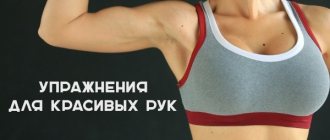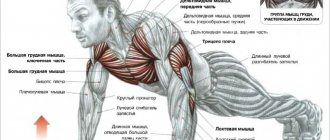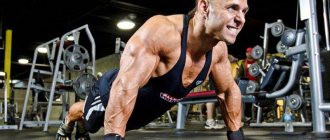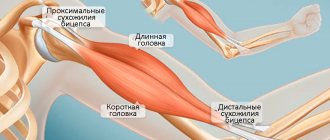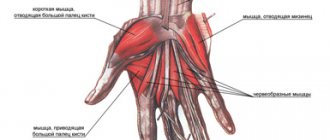Push-up – this is an exercise thanks to which today you can significantly strengthen your physical condition and pump up many muscle groups. To perform this exercise, you do not need special equipment, you do not need to ask for the help of a sparring partner or look for a suitable place to train.
Push-ups are one of the most popular and one of the most effective exercises, the benefits of which are hard to deny.
Benefits of doing the exercise
The main advantage of push-ups is its practicality - you can do push-ups anywhere: at home, in the gym, in nature. Push-ups can increase endurance, strengthen muscles, and make the body stronger and healthier.
By doing push-ups regularly, you can achieve the desired result, namely:
- Pump up your abs.
- Strengthen your hands.
- Increase leg endurance.
People who regularly do push-ups reduce the risk of cardiovascular disease, heart attack, and stroke. Push-ups can be an ideal assistant in losing weight and creating a sculpted body.
Push-up sets can be used in many types of training, and proper alternation of exercises will help develop and strengthen exactly those muscles that are needed.
How to do push-ups correctly?
Before starting a lesson, you must do the main warm-up: circular turns with your torso, shoulders, and arms.
Do not forget about the joints and hands, which should also be prepared for physical activity, especially when it comes to non-classical types of push-ups.
Today, there are many types of push-ups, based on which a certain technique is used.
In its classic form, the technique is as follows:
- Starting position: standing on the palms of your hands and toes. The conditional line from the heels of the feet to the back of the head should be smooth (the butt should not be raised up or lowered to the floor).
- Your toes should be together and your hands should be slightly wider than shoulder-width apart.
- On the count of “one,” bend your elbows and lower yourself down until your chest touches the floor.
- After this, we immediately rise up and get into the starting position.
- Further actions are performed identically. The back is straight, the butt does not rise up or fall down.
What muscles work when doing push-ups?
- Biceps and triceps (arm muscles).
- Back muscles.
- Abdominal muscles.
- Deltoid.
- Chest muscles.
- Gluteal muscles.
- Triceps and biceps brachii muscles.
- Neck muscles (partially, with the head raised up).
How to breathe correctly when doing push-ups?
For the exercise to bring maximum effect, you need not only to perform the technical component correctly, but also to master the breathing technique.
If breathing is incorrect, the following will occur:
- Shortness of breath.
- Circulatory disorders.
- Quick fatigue.
- The inability to achieve the desired result, since improper breathing will lead to a deterioration in well-being and a reluctance to exercise further.
To prevent improper breathing from causing problems, you need to remember only two things:
- Exhale on the way up.
- As you lower down, inhale, filling your lungs with oxygen.
Exercise effectiveness: results from systematic push-ups
During classic push-ups, almost all the muscles of the human body are involved. Some muscles perform a key role, while others work only partially. The main work in this exercise is performed by:
- pectoral muscles (all sections);
- triceps;
- deltoid muscles;
- biceps.
By varying the initial position of the arms and body, you can shift the emphasis of physical activity to different muscle groups.
Also, classic push-ups contribute to the active development of endurance, increasing muscle volume and strength, training the heart and vascular system, strengthening the ligamentous apparatus and tendons. The selected number of repetitions and sets largely depends on the main sports goal and the specifics of the training program in a particular case:
- to actively gain muscle mass, you need 8-12 repetitions in 3-4 sets (constantly increase the load with additional weights);
- to intensively burn fat and increase body definition, do 15-20 repetitions at a fast pace in 3-4 approaches;
- for endurance (as the main exercise), perform the maximum number of repetitions and individual sets for you.
Note! There are special push-up programs that will allow you to gradually increase the maximum number of times.
Be sure to check out:
Push-ups: working muscles, effective exercises, correct technique All the benefits of push-ups: different options for physical activity Push-ups: optimal programs for doing at home Push-ups for girls: an effective way to pump up the female body or “male prerogative”
Push-up table
The push-up program for a person with average physical fitness looks like this:
| Day of the week | Approaches, number of times |
| Monday | First approach: 30 Second approach: 25 Third approach: 20 Fourth approach: 15 Fifth approach: 10 |
| Tuesday | First approach: 32 Second approachod: 27 Third approach: 22 Fourth approach: 16 Fifth approach: 10 |
| Wednesday | First approach: 33 Second approach: 28 Third approach: 23 Fourth approach: 16 Fifth approach: 10 |
| Thursday | First approach: 35 Second approach: 30 Third approach: 23 Fourth approach: 17 Fifth approach: 12 |
| Friday | First approach: 35 Second approach: 32 Third approach: 23 Fourth approach: 18 Fifth approach: 13 |
| Saturday | First approach: 37 Second approach: 32 Third approach: 25 Fourth approach: 18 Fifth approach: 13 |
| Sunday | First approach: 40 Second approach: 35 Third approach: 25 Fourth approach: 20 Fifth approach: 15 |
Push-ups for beginners
For beginners, the main requirement is consistency. You shouldn’t try to do it a hundred times at once. Start with 10, 5 or even three repetitions and gradually increase the number of repetitions. It is also important to remember about the approaches: it is better to do three approaches 4-5 times than one approach 8-10 times.
| Day | Approaches, number of times |
| Monday | First approach: 7 Second approach: 5 Third approach: 3 |
| Tuesday | First approach: 7 Second approach: 6 Third approach: 3 |
| Wednesday | First approach: 8 Second approach: 7 Third approach: 4 |
| Thursday | First approach: 10 Second approach: 8 Third approach: 5 |
| Friday | First approach: 11 Second approach: 9 Third approach: 5 |
| Saturday | First approach: 13 Second approach: 10 Third approach: 6 |
| Sunday | First approach: 15 Second approach: 12 Third approach: 8 |
General recommendations for beginners
- You should initially try to perform the exercise efficiently. Having learned to do it correctly, it will not be difficult for you to increase the quantity each time and become better. But if you neglect the technique at first, you can stumble upon the “effect of lack of results” and after a while give up the exercise.
- Watch your breathing. Breathing is the most important aspect of any exercise, particularly push-ups.
- Keep your back straight and don’t raise your butt high, making the task easier for yourself.
- Stick to regularity.
- Do other exercises to develop and improve your overall physical fitness (running, swimming, jumping, chest exercises, abdominal exercises, arm exercises, etc.).
- Before you start doing push-ups, be sure to warm up.
Push ups
For men
The architecture of a man’s body is much stronger and more resilient than that of a woman, which is why a man needs to work on himself more and more intensively.
7 day workout:
| Day | Approaches, number of times |
| Monday | First approach: 25 Second approach: 20 Third approach: 18 Fourth approach: 15 Fifth approach: 10 |
| Tuesday | First approach: 27 Second approach: 20 Third approach: 20 Fourth approach: 17 Fifth approach: 12 |
| Wednesday | First approach: 29 Second approach: 22 Third approach: 20 Fourth approach: 17 Fifth approach: 12 |
| Thursday | First approach: 30 Second approach: 25 Third approach: 22 Fourth approach: 18 Fifth approach: 13 |
| Friday | First approach: 30 Second approach: 25 Third approach: 25 Fourth approach: 20 Fifth approach: 15 |
| Saturday | First approach: 33 Second approach: 28 Third approach: 25 Fourth approach: 20 Fifth approach: 15 |
| Sunday | First approach: 35 Second approach: 30 Third approach: 27 Fourth approach: 20 Fifth approach: 15 |
For women
Despite the opinion that push-ups are a man’s exercise, push-ups are no less beneficial for girls. And the execution may not be so difficult if you reduce the number of approaches and the number of times in each approach.
This table is designed for a woman with average physical fitness. If its implementation becomes difficult or impossible, you can do not 4, but three approaches and reduce the number of times.
Weekly training in the table:
| Day | Approaches, number of times |
| Monday | First approach: 10 Second approach: 8 Third approach: 5 Fourth approach: 3 |
| Tuesday | First approach: 12 Second approach: 10 Third approach: 5 Fourth approach: 4 |
| Wednesday | First approach: 13 Second approach: 10 Third approach: 6 Fourth approach: 5 |
| Thursday | First approach: 15 Second approach: 11 Third approach: 7 Fourth approach: 7 |
| Friday | First approach: 15 Second approach: 13 Third approach: 8 Fourth approach: 7 |
| Saturday | First approach: 17 Second approach: 15 Third approach: 10 Fourth approach: 8 |
| Sunday | First approach: 18 Second approach: 15 Third approach: 10 Fourth approach: 10 |
First week of training
- If you scored 5 or fewer pushups on the initial test, practice according to the first column of the table below.
- 6-10 push-ups in the initial test - according to the second column.
- 11-20 push-ups in the initial test is the third column for you.
- It's rare that someone can do more than 20 push-ups in the initial test. Are you one of those? Start immediately with the third week of training (below in the text). In the third week program, select the second or third column depending on the results of the initial test.
Classes are three times a week, with one day of rest between push-up days.
Table. First week of training
Recommendations
- Between sets, take a 1 minute break, but if your physical condition is still weak, the break can be increased to 1 minute 30 seconds or even 2 minutes.
- Try to keep your body straight.
- Lower yourself down until your chest touches the surface, but do not lie on the floor (this makes the task easier and reduces the result of the exercise to zero).
- If doing push-ups on your toes is too difficult, you can start with push-ups on your knees.
- You can also do push-ups not from the floor, but from a bed or chair (this reduces the complexity of the exercise).
- On the contrary, for those who have already learned how to do push-ups well, you can complicate the task and place your feet on the bed, while your hands remain on the floor. This results in an angled push-up that increases the load.
Features of technology for girls
Instead of balancing on your toes, girls at the beginner level can do push-ups from their knees.
With this execution, the level of load on the arms is reduced by approximately half, and it becomes easier to control the position of the back when performing the exercise and to push off the floor.
Try not to drop your hips down as you push out. If your lower back starts to hurt while doing push-ups, stop and take a break. If your wrists hurt after exercise, try doing push-ups on your fists or use special push-up supports.
If you do not have enough physical fitness and it is difficult to do horizontal push-ups, increase the height of your arms. As the muscles strengthen, it will be possible to lower the level of the arms.
- Your hands can be placed on the bench, thus pushing off from the bench, and not from the floor.
- The easiest level: stand against a wall at arm's length. Place your hands on the wall at shoulder level and push away from it, transferring the weight of your torso to your hands.
Kinds
From the floor
Classic push-up, in which both legs and arms are on the floor.
Usually, a person stands on the palms of his hands and on his toes, but you can also do push-ups on your fists, fingers or hands.
The exercise from the floor on the palms of the hands trains mainly the biceps, triceps, pectoral and deltoid muscles. The press also pumps.
From the knees
A more simplified version of the classic push-up, created for training people with less developed physical abilities.
It is performed in the same way as the classic exercise, but the person stands not on his toes, but on his knees. The load in this exercise is small, but for an untrained person it is significant.
The arm muscles (biceps, triceps), pectoral muscles and deltoids are also trained. The load on the press is much lower.
From the wall
Wall push-ups are one of the most difficult types of push-ups. Here, a huge load is placed on the arms and shoulder girdle, and in order to perform this exercise, you need to have serious physical fitness.
In order to complete the exercise, you need:
- Stand with your back to the wall, then lower your hands to the floor and take your starting position - on all fours.
- Climb the wall with your feet as high as possible, and pull your hands (in small steps) closer to the wall.
- Slowly bend your arms and lower yourself down until your head touches the surface.
- Then immediately straighten your arms and return to the starting position.
Wide grip
An exercise that is aimed at developing the pectoral muscles. In addition to the chest, the exercise also works well on the arms.
Done this way:
- We get into the starting position, as in a classic push-up (palms on the floor, feet on toes together).
- Then we spread our arms as wide as possible, while keeping our toes together.
- We do push-ups.
- When we go down, we inhale, when we go up, we exhale.
- You can complicate the task by adding additional supports for your arms and legs; in this case, you can go much lower, thanks to which additional muscle groups will be involved.
With a medium grip
Trains the arm muscles, abdominal muscles and shoulder girdle muscles. Also, the back muscles receive a huge load from static tension.
Push-ups are performed with a medium grip as follows:
- Starting position: standing on the palms of your hands and toes.
- The distance between the palms is slightly more than shoulder width.
- As you inhale, lower yourself down, touching the surface with your chest.
- As you exhale, rise up to the starting position.
- It is important that the head does not drop down too much and does not lift up.
With a narrow grip
Close-grip push-ups are performed to work the deltoids, triceps and pectoral muscles. Push-ups with a narrow grip are much more difficult than the classic type, which is why they are performed by people with good physical fitness.
Technique:
- Starting position: standing on your toes and palms of your hands.
- Place your palms together and place your toes shoulder-width apart.
- As you inhale, bend your elbows and lower yourself down, and as you exhale, rise up.
- In push-ups with a narrow grip, there are two options for raising the elbows: to the sides and along the body.
- If you move it to the sides, the load goes more on the chest and shoulder girdle.
- If the arms go along the body, then the load mainly goes on the shoulders and arms.
On one hand
Push-ups on one arm are needed in order to increase the load on certain muscle groups: deltoids, triceps, biceps, pectoral and others.
Mostly, people who are already able to perform several dozen classic push-ups and require additional load to develop their physical condition begin to do push-ups on one arm.
- Get into the starting position as in a classic push-up.
- Then spread your toes slightly and throw one arm behind your back.
- Bend your elbow and lower yourself down.
- Using maximum effort, push yourself out and try to rise up, taking the starting position.
- Do it several times and change the loaded hand.
With clap
The clapping exercise is performed to develop speed and strength qualities. The pectoral muscles, arm muscles and abdominal muscles are involved. Clapping push-ups are used in the training process of many athletes, so it is difficult to overestimate its importance and effectiveness.
In addition, the clapping exercise can be performed by both a professional athlete and a beginner. The only difference is the quality of execution, the number of times and the presence of complications.
Technique:
- We take a comfortable starting position.
- Toes and hands shoulder-width apart.
- Having dropped down a little, we sharply push ourselves up and at this time make a clap at chest level.
- We get into the starting position (the main thing is not to fall).
- We repeat the exercise several approaches 5-10 times.
In addition to regular clapping, you can also clap behind your back. This exercise is much more difficult than the previous one, but the result from its implementation will be significant.
Important! Before you try to do a clap behind your back, learn how to do a good push-up with a clap at chest level, since push-ups with a clap behind your back require serious reaction and speed, and if you do not have this, you can simply fall on your nose to the floor and get injured.
On fingers
Push-ups on the fingers are a little different from other types of push-ups, since the load here goes to the wrist area and develops the strength of the fingers. There are also different types of finger push-ups: push-ups on all fingers, push-ups on one finger, push-ups on three fingers and others.
Performance:
- Take the starting position, as in a classic push-up.
- Then, from the palm stand, stand on your fingers (it is very important to learn how to hold yourself in this position so that your fingers do not move apart).
- Perform push-ups, 3 sets of 3-5 times.
In the future, when your fingers get stronger and your arm muscles become stronger, you will be able to do dozens of push-ups without pain or much effort.
With weights
When doing push-ups with weights, the main emphasis is on the load on the muscles.
By “weights” we mean dumbbells, various special equipment, as well as a partner, who can be placed on the back or asked to apply a little pressure from above to increase the load when extending the arms and lifting.
The latter method is very effective, since the load can be doubled or more.
For this:
- Take the starting position: stand on the palms of your hands and toes.
- Start doing standard push-ups (to warm up).
- Then ask your partner to apply a little pressure with his hands on his back and increase the pressure each time.
- If this is not enough, ask your partner to sit on your back, but it is important that the weight of your partner does not cause you pain.
- Perform push-ups until you realize that your strength is running out.
- After the push-ups, do some light stretching to tone your muscles.
If the method with a partner is not suitable, you can put a barbell plate on your back (select the weight individually, it should be noticeable, but not too heavy).
And if push-ups are performed at home, and you don’t have a barbell plate at hand, you can use improvised means, such as:
- Packets of cereal.
- A bag of flour or sugar.
- A bag filled with things and other things.
Types of push-ups
Depending on the position of your hands when performing push-ups, you provide increased load on a certain muscle group.
For beginners, for example, girls, you can do push-ups from your knees. A more advanced level involves making the exercises more challenging by doing push-ups with weights or placing your feet on a chair.
| Muscle group | Grip | Hand position in the picture | Explanation |
| Shoulders | Brachial | 1 | To maximize shoulder work, your feet should be placed on a chair. |
| Wide shoulder | 2 | Hands are spread to a comfortable level. | |
| Trapezoid | 3 | Hands at chest level. | |
| Wide trapezoid | 4 | The arms are spread out at chest level. | |
| Rib cage | Chest | 5 | Horizontal position of the hands. |
| Narrow | 6 | Hands are brought together. | |
| Wide Angle | 7 | Palms are turned forward. | |
| Triceps | Triceps | 8 | The vertical position of the hands is close to each other. |
| Reverse triceps | 9 | Palms are turned forward, head is raised. | |
| Fast | 10 | You need to sit between your hands, feet on a chair. | |
| Back | Wide | 11 | The arms are spread as wide as possible. |
| Angular | 12 | Turn your palms forward. Hands at stomach level. |
Crossfit complexes with push-ups
- Classic push-ups – 10 times.
- Back push-ups (triceps) – 10 times.
- Wide grip push-ups – 8 times.
- Push-ups with cotton – 8 times.
- Close-grip push-ups – 5 times.
- Push-ups on your knees – 15 times.
Each exercise is performed with a break of no more than 20 seconds, preferably without a break. This set of exercises is aimed at developing speed-strength qualities, endurance, as well as the strength of the pectoral muscles, triceps, biceps, deltoids and abs.
You need to perform it in the same sequence as indicated in the complex, but increase it by 2-3 times every day so that the load on the muscles increases. Push-ups can be included in a complex of general physical training and then push-ups should be performed with a break of 1-1.5 minutes.
Program for Beginners
This program is aimed at increasing performance, overall development and strengthening the muscles of the chest and arms. The total completion time is 6 weeks. Training three times a week - you can choose which days yourself, but the break between training sessions must be at least 48 hours, that is, if the training session was on Tuesday, the next one should not be earlier than Thursday. Rest between sets should last from a minute to two.
On training days there should be no other physical activity on the working muscles, but you can do things like squats and deadlifts. If, for example, there is a desire to pump up the “neighboring” muscles (back, shoulders), then the load should not exceed 50% of the maximum. Only under such conditions will it be possible to achieve high results, otherwise the body will deplete its energy reserves without having time to restore them.
The push-ups in the beginner program are built on a medium-light-heavy basis, which will shock the muscles. Example: 2 sets of 20 reps, 2 sets of 15 reps, 2 sets of 25 reps.
If you don’t have enough strength to complete a full approach to the end, you can use drop sets, where the weight lifted is reduced, but the required number of repetitions is brought to the desired level. In this case, after refusing, you can kneel down and continue doing push-ups. I also recommend an article for your reference on how often to train.
First week.
1 workout - 2*20; 2*15; 2*25 – only 6 approaches and 120 push-ups. 2 training - 2*20; 2*17; 2*27 – 6 and 128. 3 training – 2*21; 2*18; 2*28 – 6 and 132.
Second week.
1 workout - 2*23; 2*18; 2*29 – 6 and 140. 2 training – 2*24; 2*19; 2*29 – 6 and 144. 3 training – 2*25; 2*20; 2*30 – 6 and 150.
Third week.
1 workout - 2*24; 2*20; 2*30 – 6 and 148. 2 training – 2*26; 2*22; 2*30 – 6 and 156. 3 training – 2*27; 2*22; 2*32 – 6 and 162.
Fourth week.
1 workout - 2*26; 2*23; 2*31 – 6 and 160. 2 training – 2*28; 2*23; 2*33 – 6 and 168. 3 training – 2*29; 2*24; 2*33 – 6 and 172.
Fifth week.
1 workout - 2*28; 2*22; 2*31 – 6 and 162. 2 training – 4*20; 3*15; 1*47 – 8 and 172. 3 training – 4*21; 3*15; 1*48 – 8 and 177.
Sixth week.
1 workout - 2*29; 2*23; 2*32 – 6 and 168. 2 training – 4*22; 3* 15; 1*50 – 8 and 183. 3 training – 4*23; 3*16; 1*52 – 8 and 192.
The program also involves small “kickbacks”, when the results of one of the following workouts are slightly less than the previous three - this allows the muscles to recover.
It is also possible to perform push-ups from small heights (bars, stands), which will increase the range of movements (lowering), and, therefore, increase muscle growth.
Push-ups for gaining muscle mass
To gain muscle mass, you need to regularly perform certain types of push-ups:
- Push-ups on stands (at home these can be books or dumbbells). It is performed like a regular push-up, but due to the height of the stands you can go lower, so the muscles are worked better.
- Push-ups with wide arms. Thanks to the wide stance, the load on the muscles increases, and with it, the desired result (pump up) comes faster.
- Push-ups while standing with your feet on a stool or bed . Push-ups occur at an angle, the load increases, and the upper chest muscles are well worked.
Frequently asked questions from beginners
What muscles work during push-ups?
The main muscles involved in push-ups are the pectoralis major and triceps. In addition, the upper back muscles and serratus anterior muscles are involved during push-ups.
Can push-ups replace the bench press?
It depends on your goals, but the push-up is an exercise adapted from the bench press when intensity and volume are taken into account. The push-up can be done without equipment at home, while the bench press requires equipment and additional weight.
What is the best exercise to make noticeable progress in push-ups?
One of the best pushup progressions without equipment is the assisted pushup. This push-up variation involves placing one or two knees on the ground to reduce the overall stress of the exercise.
Can push-ups make your arms bigger?
Yes! Push-ups will strengthen the triceps and will likely cause some hypertrophy in this muscle group. Since the triceps make up approximately 2/3 of the arm, there will likely be some increase in arm size.
Why do push-ups?
Push-ups train the body in a horizontal position, so it will increase the strength and muscle mass of the parts of the body that are involved in this movement.
Push-ups may be the most primitive and basic of all exercises. We all know what it is. We all try to do them and know that they are good for us.
But like squats and pull-ups, 95% of people who do push-ups do them wrong. Right now you may be wondering if you are in the 95% or the 5%. You might also be wondering what is the flight speed of a swallow.
Well, I can help you with the answers. The answer to the second question is 11 meters per second .
For the first question, I'm going to make sure you're in the 5% by the end of this article. Here are the five most common mistakes I see people make when doing push-ups. If you are at all concerned about shoulder health or muscle longevity and building functional strength, read on!
Build a strong foundation and you'll be on your way to more complex bodyweight movements in no time. But like the foundation of any home, you need to start with a solid foundation.
This strong foundation means performing functionally correct squats, push-ups, and pull-ups.
Push-ups with emphasis on triceps
There are 2 effective types of push-ups that will help you quickly pump up your triceps:
- Narrow grip push-ups. Get into the starting position: toes together, palms of your hands next to each other. Inhaling, lower yourself down, spreading your elbows to the sides or along the body, exhaling, rise up and take your starting position.
- Reverse push-up. Approach your back to the bed or high chair, place your palms on the edges and lower your pelvis down, bending your arms. The legs should be straightened forward. After this, straighten your arms and lift your pelvis up. It is important that the body moves along a conventional vertical line parallel to the bed (chair).
100 push-ups program
This program will help you reach your desired goal of 100 push-ups. In addition to following the program, you need to eat right and engage in additional physical activity (running, stretching, team sports).
Be sure to warm up and stretch before each workout. Particular attention is paid to the shoulder girdle and joints. Don't quit what you started halfway.
If you feel that you don’t have the strength to train further, reduce the number of push-ups to the norm that will be comfortable for you and continue to increase it.
So, an approximate workout for a month:
| Day | Approaches, number of times |
| Monday | First approach: 20 Second approach: 17 Third approach: 15 Fourth approach: 13 Fifth approach: 10 |
| Tuesday | First approach: 22 Second approach: 18 Third approach: 15 Fourth approach: 13 Fifth approach: 11 |
| Wednesday | First approach: 24 Second approach: 18 Third approach: 17 Fourth approach: 14 Fifth approach: 11 |
| Thursday | First approach: 25 Second approach: 20 Third approach: 17 Fourth approach: 15 Fifth approach: 12 |
| Friday | First approach: 28 Second approach: 23 Third approach: 18 Fourth approach: 16 Fifth approach: 12 |
| Saturday | First approach: 30 Second approach: 25 Third approach: 19 Fourth approach: 17 Fifth approach: 14 |
| Sunday | First approach: 33 Second approach: 27 Third approach: 20 Fourth approach: 18 Fifth approach: 15 |
| Monday | First approach: 35 Second approach: 30 Third approach: 22 Fourth approach: 18 Fifth approach: 15 |
| Tuesday | First approach: 38 Second approach: 33 Third approach: 24 Fourth approach: 19 Fifth approach: 16 |
| Wednesday | First approach: 40 Second approach: 35 Third approach: 27 Fourth approach: 21 Fifth approach: 17 |
| Thursday | First approach: 43 Second approach: 38 Third approach: 30 Fourth approach: 23 Fifth approach: 18 |
| Friday | First approach: 45 Second approach: 40 Third approach: 32 Fourth approach: 25 Fifth approach: 18 |
| Saturday | First approach: 47 Second approach: 42 Third approach: 34 Fourth approach: 26 Fifth approach: 20 |
| Sunday | First approach: 49 Second approach: 45 Third approach: 37 Fourth approach: 28 Fifth approach: 21 |
| Monday | First approach: 51 Second approach: 48 Third approach: 40 Fourth approach: 29 Fifth approach: 21 |
| Tuesday | First approach: 53 Second approach: 50 Third approach: 43 Fourth approach: 33 Fifth approach: 23 |
| Wednesday | First approach: 55 Second approach: 50 Third approach: 44 Fourth approach: 34 Fifth approach: 24 |
| Thursday | First approach: 57 Second approach: 52 Third approach: 46 Fourth approach: 36 Fifth approach: 25 |
| Friday | First approach: 59 Second approach: 53 Third approach: 49 Fourth approach: 39 Fifth approach: 26 |
| Saturday | First approach: 62 Second approach: 55 Third approach: 49 Fourth approach: 43 Fifth approach: 28 |
| Sunday | First approach: 64 Second approach: 59 Third approach: 52 Fourth approach: 45 Fifth approach: 30 |
| Monday | First approach: 67 Second approach: 61 Third approach: 55 Fourth approach: 49 Fifth approach: 33 |
| Tuesday | First approach: 70 Second approach: 65 Third approach: 57 Fourth approach: 53 Fifth approach: 35 |
| Wednesday | First approach: 74 Second approach: 69 Third approach: 60 Fourth approach: 56 Fifth approach: 35 |
| Thursday | First approach: 78 Second approach: 72 Third approach: 63 Fourth approach: 59 Fifth approach: 37 |
| Friday | First approach: 82 Second approach: 77 Third approach: 67 Fourth approach: 62 Fifth approach: 39 |
| Saturday | First approach: 87 Second approach: 80 Third approach: 70 Fourth approach: 65 Fifth approach: 41 |
| Sunday | First approach: 90 Second approach: 85 Third approach: 74 Fourth approach: 69 Fifth approach: 43 |
| Monday | First approach: 94 Second approach: 88 Third approach: 78 Fourth approach: 72 Fifth approach: 45 |
| Tuesday | First approach: 98 Second approach: 93 Third approach: 80 Fourth approach: 74 Fifth approach: 48 |
| Wednesday | First approach: 100 Second approach: 93 Third approach: 84 Fourth approach: 76 Fifth approach: 50 |
Push-up program: 30-day table for men
If the command “fall, do push-ups” can only cause you to fall, then first read the article about how to learn to do push-ups if you have weak arms.
If you have mastered the technique, but don’t yet know how to do a lot of push-ups, then with this table of push-ups for men you can increase your number in just a month.
| Day | Approaches | Total | |||
| 1 approach | 2nd approach | 3 approach | 4 approach | ||
| Day 1 | 2 | 2 | 2 | 2 | 8 |
| Day 2 | 3 | 3 | 3 | 3 | 12 |
| Day 3 | 4 | 4 | 4 | 4 | 16 |
| Day 4 | 6 | 6 | 6 | 6 | 24 |
| Day 5 | 2 | 2 | 2 | 2 | 8 |
| Day 6 | 4 | 4 | 4 | 4 | 16 |
| Day 7 | 6 | 6 | 6 | 6 | 24 |
| Day 8 | 7 | 7 | 7 | 7 | 28 |
| Day 9 | 6 | 6 | 6 | 6 | 24 |
| Day 10 | 8 | 8 | 8 | 8 | 32 |
| Day 11 | 10 | 10 | 10 | 10 | 40 |
| Day 12 | 12 | 12 | 12 | 12 | 48 |
| Day 13 | 8 | 8 | 8 | 8 | 32 |
| Day 14 | 10 | 10 | 10 | 10 | 40 |
| Day 15 | 12 | 12 | 12 | 12 | 48 |
| Day 16 | 14 | 14 | 14 | 14 | 56 |
| Day 17 | 6 | 6 | 6 | 6 | 24 |
| Day 18 | 10 | 10 | 10 | 10 | 40 |
| Day 19 | 12 | 12 | 12 | 12 | 48 |
| Day 20 | 14 | 14 | 14 | 14 | 56 |
| Day 21 | 16 | 16 | 16 | 16 | 64 |
| Day 22 | 6 | 6 | 6 | 6 | 24 |
| Day 23 | 12 | 12 | 12 | 12 | 48 |
| Day 24 | 14 | 14 | 14 | 14 | 56 |
| Day 25 | 16 | 16 | 16 | 16 | 64 |
| Day 26 | 8 | 8 | 8 | 8 | 32 |
| Day 27 | 14 | 14 | 14 | 14 | 56 |
| Day 28 | 16 | 16 | 16 | 16 | 64 |
| Day 29 | 6 | 6 | 6 | 6 | 24 |
| Day 30 | 18 | 18 | 18 | 18 | 72 |
As a bonus, your chest muscles, triceps and a little deltoids will grow.
So not only will you be able to tell everyone around you that you do great push-ups, but you will also look pretty good doing it. If it’s too easy for you to do push-ups at the very beginning, then you can start not with 2 repetitions, but, for example, with 8. Or with such an amount that is relatively easy for you. You shouldn’t do the first push-ups to the point of complete failure, so that later you won’t have the strength to get up from the floor on your own.
Bookmark this push-up chart and get started today.
Pull-ups and push-ups
Both pull-ups and push-ups are very effective exercises; they can only be beneficial if they are performed together.
The only thing is, by training both push-ups and pull-ups at the same time, you will exercise more intensely. As a result, you will begin to have difficulty performing individual cycles in each workout.
But it’s worth a try, because push-ups develop the chest muscles, and pull-ups develop the shoulders. This way your muscles and strength will grow together and faster. It is advisable to carry out training alternately: one day – push-ups, the other day – pull-ups.
World records in push-ups
While we do 50 times and dream of reaching 100, record holders calmly perform hundreds and even thousands of times, getting into various record books.
Main records:
- the greatest number of push-ups without a break - ten and a half thousand times.
- Of the women, the American Maria Tobar did the most push-ups (without a break) - 302 times.
- The world record for push-ups for the year is 1 million 500 thousand 230 times.
- In 24 hours, a person was able to do 46 thousand push-ups.
- In one hour, the men's record is 3 thousand 877 times, and the women's record is 1 thousand 20 times.
- Women's record in 30 minutes - 829 times, in 10 minutes - 450 times, and in 3 minutes - 190 times.
- The record for one-arm push-ups in 1 hour is 2521 times, in 30 minutes – 1382, and in 10 minutes – 546.
- In push-ups with fists, the record is 5557 times.
- A man was able to do 124 push-ups on one finger
- And on one hand in a handstand - 12 times.
- The record for 1000 timed push-ups belongs to Doug Pruden and is 18 minutes and 13 seconds.
- The record for push-ups on the back of the hands in one hour is 1940 times, in half an hour – 1386 times, and in 15 minutes – 627 times.
- The record for push-ups on raw eggs is 112 times.
- And the greatest number of times in one minute for a person without legs is 36 times.
Alexandrova Anastasia
Nutrition and healthy lifestyle specialist and author of myfitnesblog.com. For many years, she has successfully helped women and men lose weight and maintain a beautiful figure.
